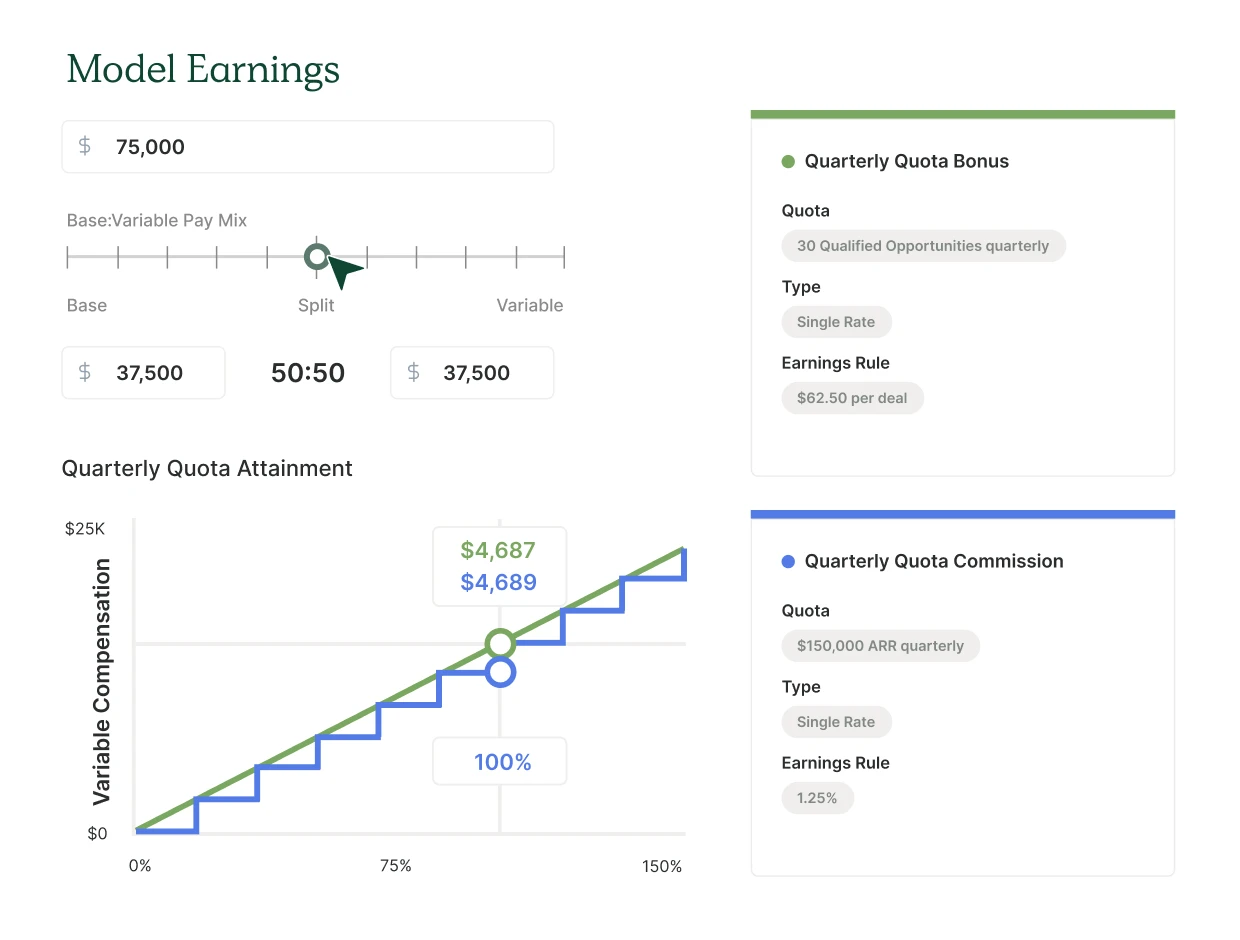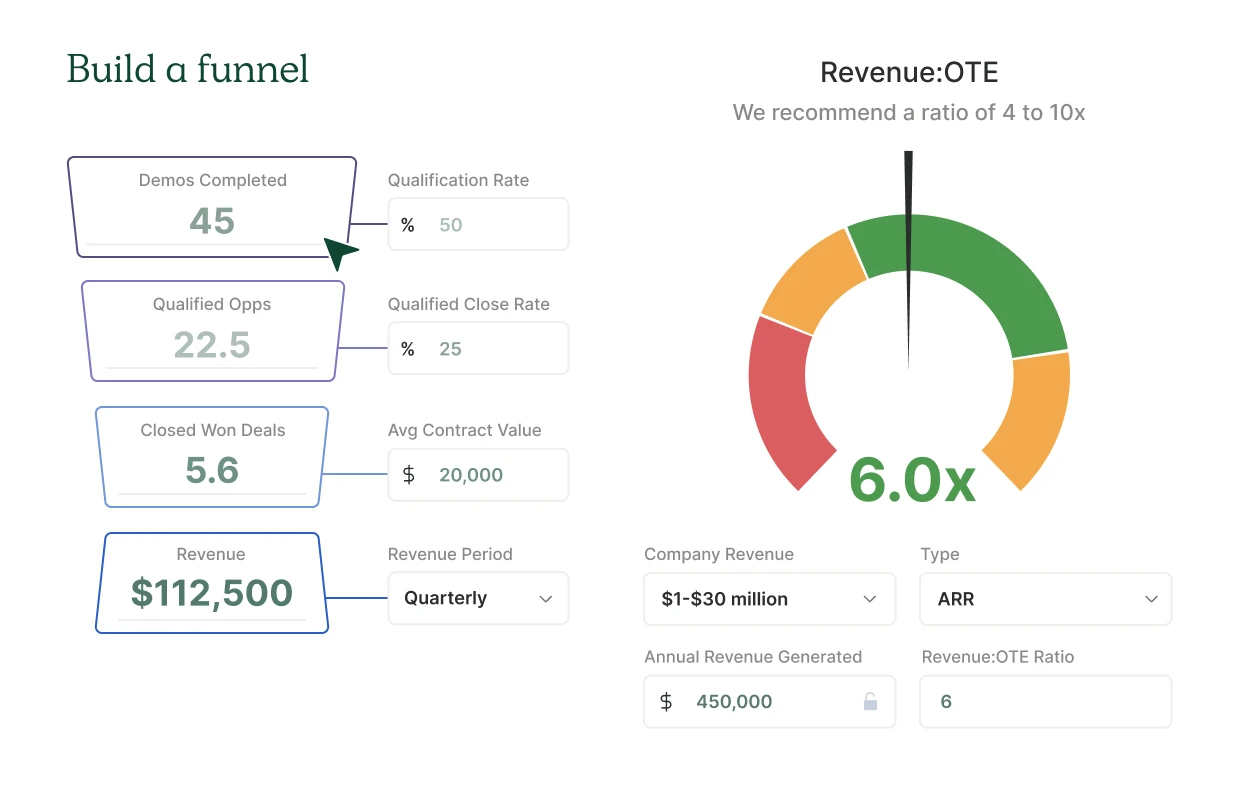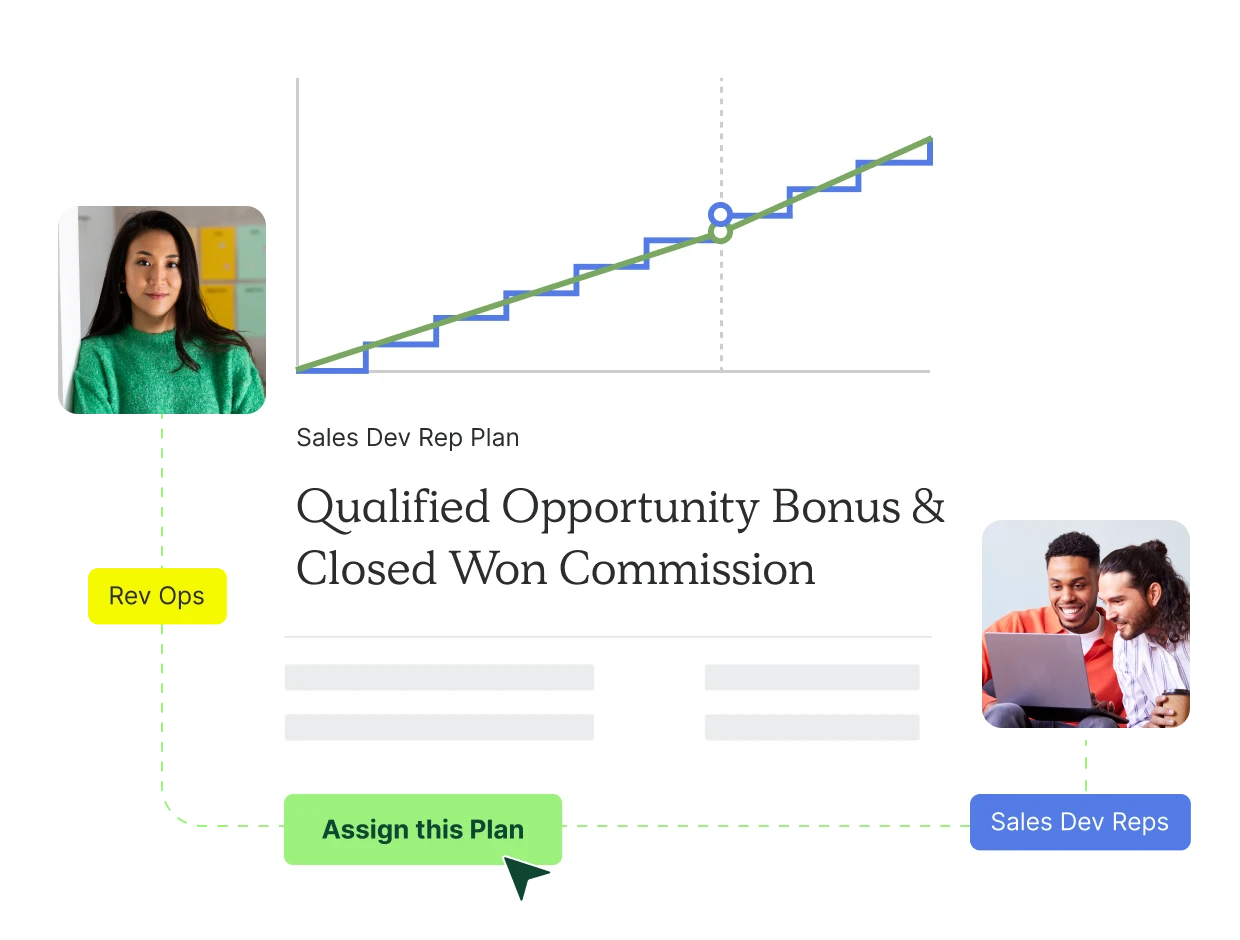Mature sales organizations
Qualified Opportunity Bonus & Close Won Commission
This SDR comp plan is a winning combination, especially for fairly mature sales organizations interested in promoting quality leads and preparing their SDRs to become AEs.

When to use this plan?
Why use a Qualified Opportunity Bonus & Closed Won Commission plan?
Good for spreading payout across sales funnel
Customize the Qualified Opps Bonus & Closed Won Commission Plan
Like this plan? Sign up for QuotaPath for free to add your business inputs and adjust the variables.
Forecast earnings & plan performance
See potential earnings based on your inputs and goal attainment progress.

Calculate your Quota:OTE ratio & Sales Funnel
Quickly assess how realistic, attainable, and healthy your OTE to quota ratio is. And, calculate the number of activities needed.

Streamline plan management
Assign the plan to your team and automate sales commission calculations. Be confident your team is being paid fairly and accurately.

How to adjust this compensation plan template
To customize this plan, you will adjust these 10 variables.
On-Target Earnings (OTE)
OTE combines base salary with variable pay and represents the total amount of money your reps can expect to earn if they hit 100% of their goals.
Pay Mix
Refers to the percentage of a salesperson’s total compensation, made up of base salary, commission, and other incentives. The most common pay mix in SaaS for SDRs is 68% base and 32% variable pay.
Company Revenue
Revenue is the total amount of income that a company generates from its primary operations. In SaaS, annual recurring revenue is one of the most important metrics.
Annual Revenue Generated
This is the annual goal for how much revenue the company generates based on the leads created from the SDR.
Revenue:OTE Ratio
This ratio calculates the multiplier increase between an SDR’s OTE and the amount of revenue the company generates based on the leads the SDR creates. The most common multiplier in SaaS is revenue 8x that of the OTE, but this will vary based on size and stage of the company.
Demos Completed
Demos Completed plans reward reps for scheduling demos that actually occur.
Qualified Opps
A “qualified opportunity” classifies as any lead the SDR creates that meets specific criteria or parameters so that reps pass along quality leads to their AE counterparts.
Closed/Won Deals
These represent any deal that an AE goes on to close that originated from an SDR-sourced lead.
Average Contract Value
Often abbreviated to ACV, this number represents the average deal size that your company sells.
Revenue Period
Your revenue period sets the frequency at which your SDR team’s revenue goal resets. In SaaS, the most common revenue period is quarterly. However, this number will vary based on your sales cycle.
Frequently asked questions
What makes this a good SDR Compensation plan?
This is one of our favorite compensation plans for SDRs because it accomplishes two tasks. First, it rewards SDRs for creating good opportunities, something they can control. And secondly, it rewards SDRs if those deals are good enough to become customers, which is good for the business.
What’s a good commission rate for this SDR comp plan?
Typically, SDR commission percentages fall between .5% to 4%.
What’s the difference between sales commissions and bonuses?
Sales commissions and bonuses both classify as variable compensation. Commissions differ from bonuses in that bonuses reward a pre-determined dollar amount that doesn’t vary. Commissions, on the other hand, consist of a percentage of the total revenue from a deal that changes most oftenly based on the annual recurring revenue (ARR) or total contract value. For example, If an SDR earns 4% of every deal that eventually closes, that’s commission. Meanwhile, if a rep earns $200 on every qualified opportunity they create, that’s a Single Rate Bonus! To see commissions and bonuses tracked automatically in QuotaPath, book a time with our team here.
What other SDR comp plans should I consider?
In addition to commissions and bonuses from deals won and opp creation, we’ve also seen SDRs earn commissions from number of meetings booked. This type of plan is the most common for early organizations that want to fill their sales reps’ calendars with meetings. For every meeting the SDR books, they earn a bonus, which will vary based on the company’s ASP (average sales price) and demo-to-close rate. Generally, the bonus falls anywhere between $20 and $300. Other SDR comp plans include the Qualified Opportunity Bonus, which pays a rep a fixed rate bonus for every qualified opportunity they pass on to sales. Or, you can offer just the Closed Won Commissionto reward the rep a set percentage on every deal that closes from their leads. In any case, QuotaPath can track and payout these plans to make it a bit easier on your finance and revenue teams.
What about activity-based SDR comp plans?
Like the meetings-booked sales compensation model in the question above, some companies will pay SDRs a bonus for hitting a specified amount of activities over the course of a week, month, or quarter. ‘Activities’ can mean anything from the number of deals made in a month to the number of meetings set or held. If you go that route, be sure to clearly define what constitutes as an activity and align your plan appropriately. In our opinion, incentivizing SDRs through qualified opportunities and/or deals won is better in the long run for your business and rep when compared to activity-based plans.
What is a sales funnel?
A sales funnel models and tracks the customer journey from the beginning stages of the lead generation through the transition to customer. All sales funnels includes a series of stages as defined by the organization with the goal to bump the customer through the stages until the purchase. Most commonly, you’ll see TOFU, MOFU, and BOFU associated to indicate top of funnel, middle of funnel, and bottom of funnel. TOFU represents the least likely to close leads that may have downloaded a company whitepaper. MOFU leads are deep in their research but are not quite ready yet to sign. And, BOFU leads are ready to make a decision.
How do you analyse your sales funnel?
Our free Sales Funnel calculator can be used by SDR and sales teams to calculate scenarios like how many meetings they need to book in order to reach quota. Use it to experiment with different close rates, average contract values, and activities to see what’s right for your business, team, and individual goals. Great for 1:1 meetings and comp planning.
What is an SDR?
In sales, an SDR is an acronym for sales development representative. This role typically sits within the sales function but may also fall under marketing. Their main responsibilities involve prospecting, setting appointments, and generating qualified leads to pass along to sales. To learn more about sales compensation for SDR teams, read our blog.
Explore similar compensation plans
What industry leaders say
Manage compensation & track commissions with QuotaPath
Deliver visibility, automation, and seamlessness across the entire compensation process.